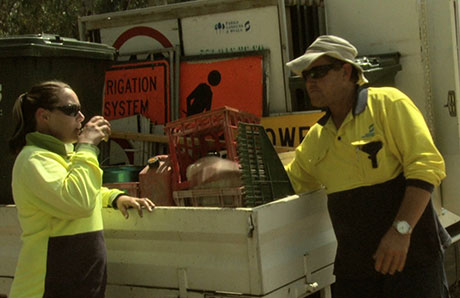

An outdoor worker, perhaps more than any other occupation, needs be on the constant look out for hazards. Not only can their geographical location change several times a day or week, the nature of each workplace can change suddenly and frequently, with the inclusion of pedestrians, vehicles and plant, wild life, as well as items left or dumped by others.
With summer now in full swing, exposure to high levels of UV radiation from the sun and extreme heat can both pose risks to health and safety.
If your occupation requires you to spend large periods of time working outdoors, here are several simple tips to help keep you cool and safe:
- Look out for warning signs
If you are working in extreme heat and humidity for long periods of time, your internal mechanism can become compromised and not allow the body to cool itself off…. you will start to feel sick. The warning signs to look for include cramping, thirst, dizziness, nausea, lack of sweat, faintness, fever and or headaches.
- Hydrate
Make sure you hydrate regularly. Drink small amounts of water frequently (every ten to fifteen minutes) and avoid alcoholic or caffeinated beverages like coffee, energy and soft drink.

- Snack right
Try to eat fruit rich in vitamins and essential elements. Such as potato skins or a hand full of raisins. Snack on a banana, it is full of potassium which is one of the important minerals we lose when we sweat.
- Work smarter
Tasks that require excessive physical exertion should be tackled early in the morning. If this is not possible, try to rotate jobs that must be tackled by hand and look out for a cool shady spot where you can rest and recover. Watch out for your workmates and try to seek shade especially between the hours of 11am and 3pm when UV levels exceed 3.
- Clothing
Wear clothing that offers you maximum protection: loose light coloured clothing preferably made from natural fibres is more comfortable, reflects heat, allows ventilation and sweat to evaporate. A hat to protect the face and neck and sunglasses to protect the eyes, are important.
- Sunscreen
Apply a sunscreen that has a sun protection factor (SPF) of at least 30 +, 15 minutes before going out in the sun. Sunscreen should be applied to dry skin every two hours, more often if in water or sweating profusely.
Finally, make a point of being able to recognise the early signs of sun damage. These usually take the form of lumps, bumps, sores and spots.
It is important to note that most skin cancers even melanoma can be cured providing medical attention is sought in the very early stages. So check your body regularly and know what you are looking for.
For more safety tips for the outdoor worker, check out our latest Outdoor Worker Safety series.

